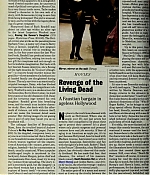|
Simply Streep is your premiere online resource on Meryl Streep's work on film, television and in the theatre - a career that has won her acclaim to be one of the world's greatest living actresses. Created in 1999, Simply Streep has built an extensive collection over the past 25 years to discover Miss Streep's body of work through thousands of photographs, articles and video clips. Enjoy your stay and check back soon.
|
|
Review: Revenge of the Living Dead
Newsweek ·
August 03, 1992
· Written by David Ansen
| ||
No place in the world is as obsessed with youth as Hollywood. Where else do people over 30-not just actors but writers-feel compelled to lie about their age to protect their careers? It’s a place where only plastic surgeons and personal trainers have real job security. If fear of aging is as American as apple pie, it’s in part because Hollywood, hand in hand with Madison Avenue, has trained us so well to associate happiness, desirability and fun with the sight of a firm tush. Robert (“Back to the Future”) Zemeckis, a key Hollywood player, has obviously observed this malady firsthand. He has made that fear, that obsession, the subject of his mascara-black comedy Death Becomes Her, in which Meryl Streep and Goldie Hawn–one driven by vanity, the other by revenge-make a Faustian bargain for eternal youth.
The satire gets off to a mean and merry start as it sets up the rivalry between the vain, preening actress Madeline Ashton (Streep) and her drab childhood friend Helen Sharp (Hawn). When Madeline steals and marries Helen’s fiance, the famous plastic surgeon Ernest Menville (Bruce Willisy-nothing like having the best nip-and-tuck man around the house-Helen goes into a precipitous decline, gaining 200 pounds and landing in a mental hospital. What snaps her out of her depression is the thought of bloody revenge, and when we next see her, seven years later, she has transformed her 50-year-old self into a svelte and glamorous author of a beauty guide. And she is ready to ensnare the bedraggled, alcoholic Menville, wretchedly married to Madeline, into her murderous plot.
Up to this point, Zemeckis’s film bears an uncanny resemblance to Streep’s 1989 comedy, “She-Devil.” She’s essentially playing the same self-involved, supercilious character, and playing her with hilariously evil zest. But now the film takes a Gothic turn, with the appearance of Isabella Rossellini as the mysterious purveyor of an elixir that will keep Madeline alive, and rejuvenated, forever–even after she’s been murdered.
It’s nice to see Zemeekis making a comedy with teeth again. “Death Becomes Her,” written by Martin Donovan and David Koepp, returns to the abrasive mode of Zemeckis’s underrated “Used Cars” (1980). But it also bears a kinship to the cartoonish physical distortions of his “Who Framed Roger Rabbit,” as he brings on some dazzling special effects: Streep appears with her head, literally, screwed on backward, and Hawn strides along with a see-through hole in her belly. Zemeckis has always relished technical challenges; once again he pulls them off with high style.
Yet oddly, the more fantastical and grotesque this comedy becomes, the more conventional it seems-and the less it has to say. Somewhere in the middle of the movie, the characters take a back seat to the pyrotechnics, reality is replaced by cliffhangers and Gothic claptrap, and the laughs start to dry up. Satire needs a social context, but the filmmakers have little to say about the culture that created these age-obsessed women. Still, even when “Death Becomes Her” wanders off course, it remains worth rooting for. And the stars are never less than fun to watch. See it for the pleasure of Streep’s and Hawn’s lusty, self-mocking performances, for the chance to see Willis deftly play against type and, not least of all, for the marvelously befuddled cameo by Sydney Pollack as a doctor trying to wrestle with the notion that his walking, talking patient is actually stone-cold dead.














